
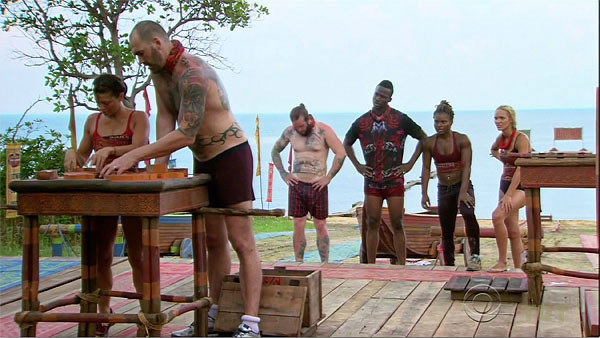
During the reward/immunity challenge on the first episode of Survivor: Kaoh Rong Wednesday, Brawn is working on the puzzle (or messing up the puzzle) and Kyle/Jason yells something along the lines of “Come on, we’re brawwwwwn!”
Besides making me laugh at him and wonder if people go through withdrawal from steroids, I realized this first episode needs to be analyzed through the lens of social identity theory (SIT) and priming theory.
For those of you new to this here column, the whole point of these endeavors is to entertain, yes, but to also utilize mass communication theories to understand how and why stuff happens on the show. This is what I do in my daily life, sort of. Does it always work with Survivor? Of course not. We’re shown such a tiny amount of footage from what actually happens on the island and, of course, that footage is specifically chosen by producers to fit into a long-term narrative. But it is useful to think about theory when we try to understand human behavior.
Now, last year I started the season off with a bit on social identity theory and I certainly did not want to do the same this year. But I don’t think there’s any avoiding it. I mean, I could, but that would make me cry or something.
Seriously, last season we talked about the “beach people” and the “shelter people.” The Ta Keo tribe identified themselves through those groups early in Second Chance, but that was a season of returning players and numerous pre-season alliances. Kaoh Rong is different for a bunch of reasons.
And this is why SIT works even better, but why we also have to turn to priming.
So let’s recap a bit about what these theories actually explain. SIT basically argues for two main attributes of people: One, that being a part of a group with others with similar characteristics or belief structures is not only nice, but important for people’s sense of identity. And, second, people always want to view themselves positively and want others to view themselves in the same way. And, through these two attributes, people become emotionally attached to membership in their groups.
With priming, which I talked about last year also, it’s basically a theory that argues that when you introduce one piece of information to someone, if that info is made salient, it will impact how that person interprets the next piece of information that enters their brain.
On the surface, these theories may seem a little complicated and, maybe, you think, they have nothing to do with Survivor. I disagree. And let me explain why.
Both of these theories are rooted in deep traditions of social and cognitive psychology, which are the scientific studies of behavior. If you were to visit a psychologist or read about research done to understand behavior, these are the kinds of theories researchers use.

For our purposes, we need both theories to see what’s happening on Kaoh Rong. You see, producers grouped castaways into tribes post-hoc, meaning they had their cast and then labeled them beauty, brains or brawn. What this does is, unlike Second Chance, they’ve been put into groups already and not organically, or have membership based on an attribute – real or imagined (in the case of Alecia) – and they’ve been primed by that attribute.
Basically, what this all means is that producers have primed castaways by telling them that they’re beautiful or strong or smart and put them into groups based on those characterizations. Because of SIT, we know that these people are going to cling to membership in these groups because that’s what people do. And because of priming, we know that every single thing that happens until some merge or tribe shakeup of sorts, will be viewed through a prism of that characteristic.
For an example, you can read a recent study some colleagues and I published. Basically, we wanted to see if people stereotyped white, black and Latino baseball players. Through an experiment, primed people by showing them a photo of a black, white or Latino player and then made them read a paragraph about that player. Now, the people who took the experiment were put into three groups. One group saw photos of white players, one black and one Latino. But they all read the same paragraphs. So, in one case, for example, the paragraph talked about how smart the player was, and this is a stereotype (intelligence) usually attached to white players. We wanted to see if, when primed by a photo clearly showing either a white, black or Latino player, the people would rate them differently even if they read the same paragraph. And we also wanted to see if mattered depending on the race of the person taking the experiment (SIT). Basically, we found that people stereotyped for a lot of reasons and the priming mattered and so did membership in specific groups.
An illustration of this comes from the Brawn tribe. Besides Kyle/Jason (I refuse to call him one or the other) roaring at Jennifer during the puzzle, think about how that tribe operated. Based on not much interaction at all, most members immediately ostracized Alecia because she didn’t fit their predetermined standard of brawn. And then they did the same with Darnell even before he messed up the challenge. And at Tribal Council, they talked a lot about brawn.
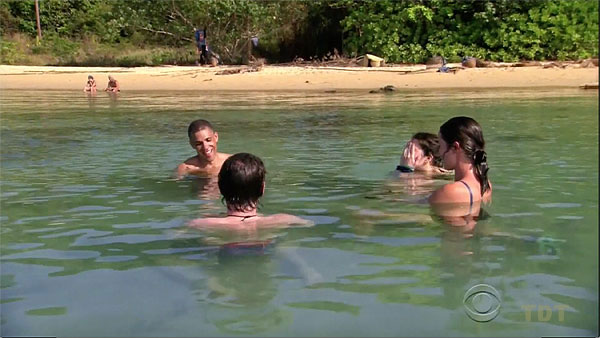
Really, we saw all tribes doing this. Caleb wondered why Tai was on his tribe. Neal implicitly and explicitly questioned Debbie’s inclusion in their tribe. We also saw groups emerge with groups. On the Brain tribe, they all identified as smart, but then four made a group within a group based on age. That’s SIT in action. Throughout the episode, really, we saw examples of castaways who already identified with their producer-prescribed characteristic and played up those aspects. Even Scot, of course, talked a lot about brawn and mocked his lack of beauty or smarts. My guess is, in real life, without primed to identify as brawn, he might not do that so openly. And the entire brawn tribe might have coalesced far differently if, say, they were thrown on that tribe and called “no collar.” Maybe, in that case, it’s Jennifer, who has a white-collar occupation, who’s immediately looked at differently and her tribemates look for reasons to boot her.
I mean, of course Darnell still might have gotten the boot since he messed up the challenge, but, of course, maybe Darnell doesn’t step up to dive and lose the mask if he didn’t already feel like an outsider because of the group’s shared identity.
Because castaways were primed with attributes and then put into specific groups this season, I think watching how they identity with these groups before and after a tribe shakeup with be very interesting. I didn’t watch Cagayan thinking about social identity and priming because, you know, I wasn't writing this column then. But I’m definitely going to thinking about this now. And I’m certainly excited for the season.
Enough with the theories, though, let’s talk about first impressions:
Brains - Chan Loh
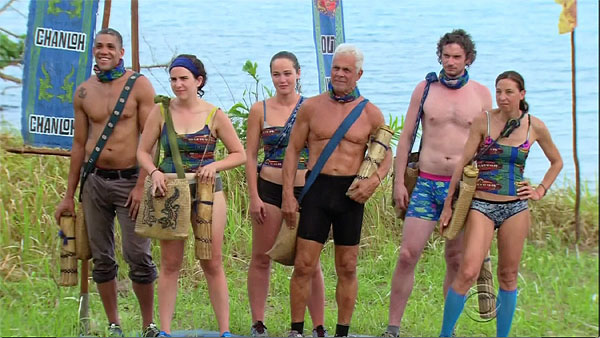
- Peter B. – I’m not sure what to think of this guy. He seems smart, but he also seems totally full of himself and it might be difficult for him to fade into the background at times. Also, does he really look much like the President?
- Debbie W. – Holy poopballs. This woman might be nuts. Did you enjoy how producers subtly mocked her by labeling her a “waitress” in one confessional and a “chemist” in another? I’m just not sure she lasts one vote. Just to rid themselves of the annoyance I bet the Brains boot her when they get the chance.
- Joseph D. – Out of everyone of the show, I think we may have gotten the least from Joseph. At one point, while watching, I said I hope I’m in that kind of shape when I’m 71. Then I realized I’m not in that kind of shape now, and I’m not halfway to 71 just yet. Then I felt sad. I like Joe, though.
- Aubry B. – Man, have we ever seen a turnaround so quickly? At first, it seemed like Aubry was deadweight, a little crazy and definitely not long for this game. And then she gets better and absolutely dominates the challenge. I’m rooting for her.
- Neal G. – We didn’t get too much from Neal this week, but what we did see, I liked. I thought he made some good alliances. He was the catalyst for the subgroup based on age, and I think that was a good one. Now we just have to see if Neal is adaptable. He’ll need to be.
- Elisabeth M. – Last week I wondered what wasn’t to love about Elisabeth. I’m still wondering the same thing. She’s still my main pick to win this thing.
Beauty – Gondol
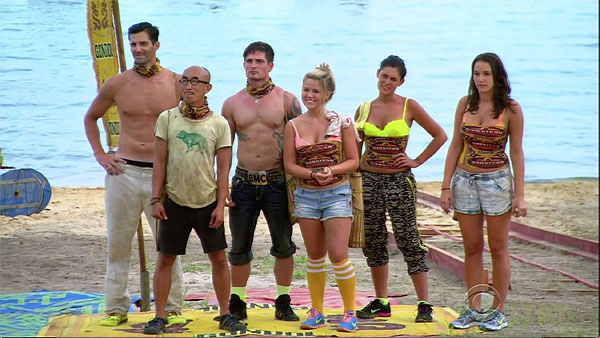
- Nick M. – Oh gosh. So I thought this guy came across completely awful in his Q&A on CBS.com. Well, I would argue he came across just as bad this week. Seriously, ego, bro, ego. The parts about how “good looking” he is. Not only did it sound unrealistic, I just feel like any intelligent person would understand how they might come across. Either Nick doesn’t get it or he doesn’t care. And neither of those characteristics get you far in this game. We’ll see if I’m wrong. It’s early.
- Caleb R. – Again, as someone who’s never seen him on Big Brother, Caleb came across better than I expected. Of course, he also called himself “beast mode cowboy” and seemed to have an adorned belt buckle to match. I’ll let those facts speak for themselves, OK?
- Julia S. – She’s young, but she came across a whole lot better than I expected. We didn’t see much of her, but I’m interested to see if she can float under the radar, strike when she can and make Boston proud. She can then be celebrated with a parade around Boston Common. She and Boston Rob can wave to the crowd from a duck boat or something.
- Michele F. – Michele seemed to be a little all over the place this episode, delivering lines about total trust and then five seconds later changing her mind. With that said, Michele seemed to be a good leader on this tribe, drove a lot of the action and definitely narrated more than anyone besides maybe Nick. I think those are all really good signs.
- Tai T. – I want this guy to be on every single season of Survivor. I don’t think he has a shot in hell of winning now, but he totally entertained me. And he’s super easy to root for. Go Tai.
- Anna K. – I’m still on the fence about Anna. In my preview, I picked her as my favorite from this tribe, but I’m not sure anymore. I think, at times, she came across well, but at others, she faded into the background while others took the lead. I’m going to reserve my judgment while still rooting for Anna.
Brawn – To Tang
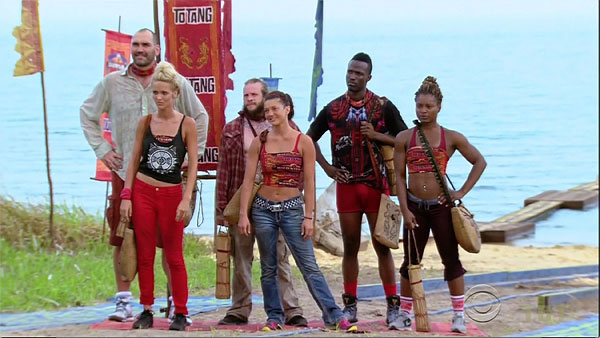
- Scot P. – Ah, Scot Pollard. I feel like he came across a little better than I thought he would, but it’s still not happening. If he makes a tribe shakeup, he’s gone after that. He may not have the worst social skills of anyone on this tribe, but they sure aren’t great.
- Kyle/Jason – I’m not sure if I’ve disliked a castaway so much so quickly as I did Kyle/Jason this week. The frustrating part is I think he has some game in him, but he came across as a sexist moron most of the time. The fact that he talked down to basically every female on the tribe, that he roars a lot, that he refuses to call Alecia anything but “blondie,” that he himself to seem to suck at the challenge, that he couldn’t help but praise himself in confessionals … I could go on and on. I’ll stop and say this dude might last on brawn, but he’s gone quick at any shakeup because there’s no way his oversized and seemingly unearned ego will be able to stay in check when he’s not in power. And he may not even last till a shakeup. The ridiculous over posturing at tribal should make everyone but Scot come together to ditch him next time.
- Jennifer L. – That ear and bug thing? Oh my god it freaked me out. Good for Jennifer for powering through. I really liked her this episode for the most part. She seems like a good leader, but we’ll see if some of these dudes let her be one. I have a feeling they won’t.
- Alecia H. – Yeah, I mean, no. Not going to happen. I’m a better fit on brawn than Alecia. And a mental giant? Who writes two letters on parchment before realizing the cap is on? Um, yeah, no.
- Cydney G. – I’m still loving Cydney, but I’m not sure she’s in a good position right now. I hope I’m wrong, but why her, Darnell and Alecia didn’t seem to try to band together worries me. We shall see.
So there we go. I’m excited for the season. It was a pretty good beginning for a non-all-star season. Let’s hope it continues.
We’ll talk again next week. Have a great week and let’s talk in the comments.
 Pat Ferrucci started watching Survivor when episode two of Borneo first aired. He’s seen every episode since. Besides recapping here, he’ll be live-tweeting this season from the Mountain Time Zone. Why? Because nobody cares about the Mountain Time Zone except when they want to ski. Follow him @patferrucci for Survivor stuff and tweets about anything and everything that enters his feeble mind.
Pat Ferrucci started watching Survivor when episode two of Borneo first aired. He’s seen every episode since. Besides recapping here, he’ll be live-tweeting this season from the Mountain Time Zone. Why? Because nobody cares about the Mountain Time Zone except when they want to ski. Follow him @patferrucci for Survivor stuff and tweets about anything and everything that enters his feeble mind.
- Index of articles
- Pre-season cast preview
- Ep.1: Producers prime those identities right away
- Ep.2: Jenny shows everyone how not to play Survivor
- Ep.3: How self-perception took down the Brains
- Ep.4: Brawn depletes its ability to keep Alecia around
- Ep.5: An exchange Anna hopes to forget
- Ep.6: Ironically, Peter is not so attractive?
- Ep.7: Emerging power
- Ep.8: A story Nick didn't quite understand
- Ep.9: Lack of regulation dooms Debbie
- Ep.10: Tai doesn't let ethics tie him down
- Ep.11: Michele follows along to someone else's agenda
- Ep.12: Tai's a metaphor for a bad player
- Ep.13: A winner's edit?
- Pre-Ep.14: Jury Jeopardy
- Ep.14: So this is how it ends...